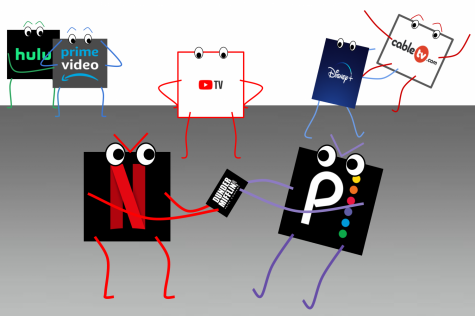Streaming Services on the Rise as the Pandemic Continues
December 21, 2020
Television streaming services are on the rise as the pandemic prolongs social distancing guidelines. Many customers have flocked to the ever increasing number of networks that promise fast and easy entertainment.
Reed Hastings, cofounder of Netflix, created the company’s business model after receiving a $40 late fee from a Blockbuster. He wanted a more convenient way to watch television on his own time; one year later, the subscription based streaming service was launched.

By the early 2000s, Netflix had become a popular streaming site nationwide. Amazon Prime Video and Hulu soon followed, creating competition in the new industry and drawing more consumers. The streaming services grew and improved, making deals with television networks and film studios to be able to add their shows and movies to their ranks. In 2013, Netflix and Amazon became the first to branch out into creation, releasing the first Netflix and Amazon Original Series, “House of Cards” and “Alpha House”, respectively.
Over the next two decades, the streaming industry continued to grow in popularity because of its ease and convenience. More shows were added throughout the 2000s, and other companies began branching out into the industry. Youtube released Youtube TV in 2017, including live streaming of channels without cable, and Apple TV and Disney+ came out in 2019.
Even with the popularity these companies already had, 2020 has been a banner year for streaming television. Since Covid-19 struck the US in March and people were forced to keep to themselves, they turned to television. Streaming subscriptions have skyrocketed and companies like Netflix, Amazon and Hulu have been working hard to keep their product updated and interesting for the public, looking to add new shows and novel ways of engaging their audience. Netflix released Netflix Party in the spring, allowing customers to watch TV with friends while staying at home. HBO Max recently announced a deal with Warner Brothers Studio that, starting in 2021, all Warner Brothers movies being released in theaters will simultaneously be released on the streaming platform to allow viewing from home.
Additional competition has been added recently as more networks have announced plans to create streaming platforms. One that has sparked interest and concern among Netflix viewers is Peacock, the NBC streaming service that was released in July. It declared its plan to remove popular shows like “The Office,” “Parks and Recreation,” and “Brooklyn Nine-Nine” from their old platforms, forcing fans to subscribe to their new site.
As these television streaming companies continue to grow and the Covid-19 virus holds social distancing guidelines in place, many fear that the end of cable TV is near. Cable networks have been growing obsolete for years as streaming allows thousands of choices in entertainment at any time. Younger viewers seldom watch television on cable channels, if at all. Even daily news and sports–old draws to cable networks–can be found elsewhere. Streaming sports games has become increasingly common, especially as many sports networks create their own apps and streaming sites, and news (though not always as accurate) is often viewed through Twitter, Instagram, and other forms of social media.
The streaming service industry will only continue to grow in the years to come, and it may prove to be the future of television.


